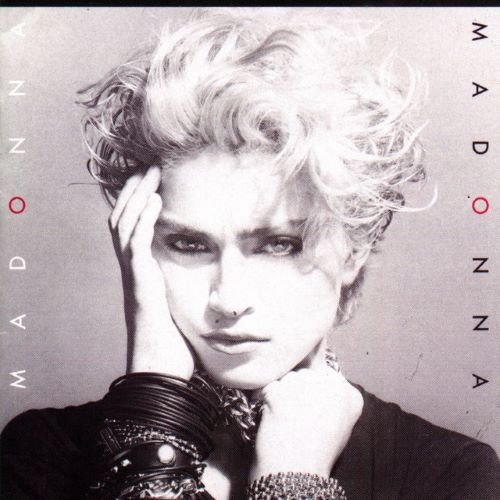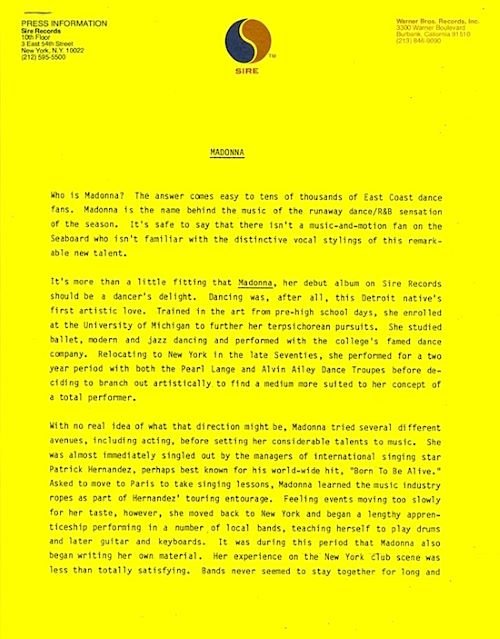FEATURE:
Physical Attraction
Madonna’s Incredible Eponymous Debut Album at Thirty-Nine
__________
I usually mark Madonna anniversaries…
IN THIS PHOTO: Madonna in 1983/PHOTO CREDIT: George Holz
when it comes to albums and singles. On 27th July, 1983, Madonna released her eponymous debut. I have written about the album before, but I think it is important to remember it each year. Although Madonna’s debut single, Everybody (which was included on the album), came out in 1982, she put her debut out in 1983. That was the year I was born. It is exciting to think the debut album of a future Pop queen came out a couple of months after I was born! I wanted to push people towards it and get it on vinyl as it is a sensational and underrated debut. It sounds remarkable on vinyl and, when it turns forty next year, let’s hope it gets a reissue. We have the thirtieth anniversary of Erotica later in the year, so I am not sure whether there are plans to reissue that album. Madonna is an L.P. that contains songs that have stood the test of time. Maybe the production sound is dated to a degree, but the fact Madonna composed most of the songs on her debut shows the talent and ambition she had in 1983 – at a time when many of her Pop peers were mot writing their own music.
I am going to come on to a couple of reviews for Madonna soon. I want to start with some information and background about the album from Today in Madonna History. It is surprising to hear that Madonna was originally disappointing by the album and was not happy with the overall sound:
“On July 27 1983, Madonna’s eponymous debut album was released by Sire Records. The record was renamed Madonna: The First Album for the 1985 international re-release of the album.
The album was released with 8 tracks (produced by John “Jellybean” Benitez, Mark Kamins and Reggie Lucas):
1. Lucky Star
2. Borderline
3. Burning Up
4. I Know It
5. Holiday
6. Think of Me
7. Physical Attraction
8. Everybody
Five singles were released from The First Album:
1. Everybody (October 6 1982)
2. Burning Up (March 9 1983)
3. Holiday (September 7 1983 – UK)
4. Lucky Star (September 8 1983)
5. Borderline (February 15 1984)
“Madonna was unhappy with the whole album, so I went in and sweetened up a lot of music for her, adding some guitars to ‘Lucky Star’, some voices, some magic… I just wanted to do the best job I could do for her. When we would playback ‘Holiday’ or ‘Lucky Star’, you could see that she was overwhelmed by how great it all sounded. You wanted to help her, you know? As much as she could be a bitch, when you were in a groove with her, it was very cool, very creative.”
— John “Jellybean” Benitez talking about Madonna and the album”.
Even though she went on to record stronger, more varied, personal and acclaimed albums, Madonna does deserve a lot more respect than some people give it credit for. There were a lot of positive reviews for it upon its release, but many assess it now as a promising debut…albeit one that had flaws and only had one or two good songs. Madonna’s voice was still developing, and her lyrical voice would embolden, expand and strengthen on subsequent albums. Madonna is one of the most important debuts ever, as it introduced her to a wider audience. How many people in 1983 would predict where her career would go?! Would they imagine we’d be talking about her in 2022?! Before I get to some reviews, This Is Dig! wrote about Madonna on its thirty-eight anniversary last year:
“A SEEMINGLY ENDLESS SUCCESS
Sharing that addictive intensity of her early years, these three quite different cuts remain the highlights from Madonna’s self-titled debut album. Meanwhile, other songs position themselves closer to the club-soul market of the day. That debut single, Everybody, had featured on the demo tape that persuaded legendary impresario Seymour Stein to sign the ambitious young singer to Sire Records in the first place. A starker electro-pop nugget, it became a decent-sized dance hit and was supported by a simpler in-performance video. Burning Up was the second single to get issued ahead of the Holiday breakthrough and was an urgent pop-rock number that became the singer’s first hit in Australia, where it landed at No.13.
The album was rounded off by I Know It (urgent and melodic), Think Of Me (the record’s most obvious R&B shuffler) and Physical Attraction (a spikier dance cut that almost sits at the sweet-spot of a Burning Up and Everybody Venn diagram), and Madonna’s reputation built over the course of the following year, as each single release did better than the last. By the time Lucky Star had peaked stateside, however, it was causing problems. Madonna’s second album, Like A Virgin, was in the can but found itself delayed by the seemingly endless success of the music she had recorded many months earlier.
“SHE WAS A TRUE PROFESSIONAL”
As was her way, Madonna was eager to move on. But her debut album’s singles just wouldn’t be silenced. Holiday became a hit all over again in Europe in 1984, and, by August 1985, Madonna was at No.1 in the UK with Into The Groove, with a reissued Holiday sitting just one place behind it in the charts. The following year, Borderline would re-enter the British charts and climb to No.2, while, in 1991, Holiday would yet again reach the UK Top 5.
Also in 1985, the Madonna album itself would be reissued, with new artwork, in Europe as The First Album, but the original Gary Heery sleeve shot is a masterpiece among Madonna’s album covers. Designer Carin Goldberg recalls: “She came in with a lot of bracelets on… that was the one iconic thing about her outfit, besides the rag in her hair… Madonna was probably the easiest job I ever had… She was a true professional, even at that young age.”
Madonna’s unique look, provocative agenda, assured self-confidence and the evocative energy of her records and videos quickly made her an MTV titan. Following her debut album’s release, on 27 July 1983, first the US, then the rest of the world, was gripped by Madonna-mania, and the album that launched her would sell more than ten million copies globally and enjoy 168 weeks on the Billboard charts. Madonna’s pop-theatre would scale higher creative peaks, but nothing would beat the charming energy of her self-titled debut album”.
Even if the production is typical of the 1980s and might seem dated to some, Madonna is a timeless album that will be inspiring and moving people for decades to come. I want to highlight AllMusic’s review of the biggest and most important (in my view) album of 1983. It must have been really exciting for Madonna fans that year to get her talked-about and incredible debut album:
“Although she never left it behind, it's been easy to overlook that Madonna began her career as a disco diva in an era that didn't have disco divas. It was an era where disco was anathema to the mainstream pop, and she had a huge role in popularizing dance music as a popular music again, crashing through the door Michael Jackson opened with Thriller. Certainly, her undeniable charisma, chutzpah, and sex appeal had a lot to do with that -- it always did, throughout her career -- but she wouldn't have broken through if the music wasn't so good. And her eponymous debut isn't simply good, it set the standard for dance-pop for the next 20 years. Why did it do so? Because it cleverly incorporated great pop songs with stylish, state-of-the-art beats, and it shrewdly walked a line between being a rush of sound and a showcase for a dynamic lead singer. This is music where all of the elements may not particularly impressive on their own -- the arrangement, synth, and drum programming are fairly rudimentary; Madonna's singing isn't particularly strong; the songs, while hooky and memorable, couldn't necessarily hold up on their own without the production -- but taken together, it's utterly irresistible. And that's the hallmark of dance-pop: every element blends together into an intoxicating sound, where the hooks and rhythms are so hooky, the shallowness is something to celebrate. And there are some great songs here, whether it's the effervescent "Lucky Star," "Borderline," and "Holiday" or the darker, carnal urgency of "Burning Up" and "Physical Attraction." And if Madonna would later sing better, she illustrates here that a good voice is secondary to dance-pop. What's really necessary is personality, since that sells a song where there are no instruments that sound real. Here, Madonna is on fire, and that's the reason why it launched her career, launched dance-pop, and remains a terrific, nearly timeless, listen”.
One of my favourite Madonna albums, her debut is thirty-nine tomorrow (27th July). I do hope that there are plans to reissue it one day, as it is hugely relevant to this day. I listen to modern Pop, and so much of it nods back to Madonna. I am going to end with a review from Pitchfork and their thoughts about a masterful and hugely accomplished work:
“Part of what gives Madonna such affecting rhythm is its use of electronic instruments that sounded like the future then and typify the ’80s sound now—instruments like the LinnDrum and the Oberheim OB-X synthesizer. Disco had brought dance music to pop’s forefront, where producers like Giorgio Moroder traded its saccharine strings for robotic instrumentation, but by the early ’80s, the genre had cooled off. People still danced to synthesizers, but their positioning was crucial—both within culture and musical compositions. The Human League and Soft Cell scored two of 1982’s biggest and most synthetic smashes, but back then the gulf between punk-derived new wave and bygone disco seemed wider than it ever really was. Disco and disco-adjacent stars like Donna Summer and Michael Jackson still were programming their hits, but the overall focus was back on a full-band sound. There’s no shortage of organic instruments on Madonna’s debut—“Borderline” wouldn’t be the same without the piano’s melodic underscoring, standout album cut “Physical Attraction” without its funky little guitar line—but the slinky digital grooves often take center stage. Through this, Madonna is able to achieve an almost aggressive twinkling that still feels fresh: the effervescent fizz at the start of Carly Rae Jepsen’s “Cut to the Feeling” seems cribbed straight from “Lucky Star.”
Madonna vaguely criticized her debut’s sonic palette while promoting its follow-up, 1984’s Like a Virgin, but its focus is part of what makes the album so memorable, so of a time and place. She would soon become known for ritual pop star metamorphosis, but with a clearly defined musical backdrop, Madonna was able to let shine her biggest asset: herself. The way Madonna’s early collaborators talk about her—even the ones who take issue with her, like Reggie Lucas, who wrote “Borderline” and “Physical Attraction” and produced the bulk of the album—often revolves around her decisiveness, her style, the undeniability of her star quality. Some of these songs, like the self-penned workout “Think of Me,” aren’t all that special, but Madonna telling a lover to appreciate before she vacates is so self-assured, the message carries over to the listener. And when the material’s even better, like on “Borderline,” the passionate performance takes it over the top.
Maybe the New York cool kids rolled their eyes at the Midwest transplant after she blew up, but she had effectively bottled their attitude and open-mindedness and sold it to the MTV generation (sleeve of bangles and crucifix earrings not included). Innocent as it may look now, compared to the banned bondage videos and butt-naked books that followed, Madonna was a sexy, forward-thinking record that took pop in a new direction. Its success showed that, with the right diva at the helm, music similar to disco could find a place in the white mainstream—a call to the dance floor answered by everyone from Kylie to Robyn to Gaga to Madonna herself. After venturing out into various genre experiments and film projects, when Madonna needs a hit, the longtime queen of the Dance Songs chart often returns to the club. This approach doesn’t always work, as her last three records have shown, but you can’t fault her for trying to get back to that place where heavenly bodies shine for a night”.
Truly a magnificent, exciting, and fresh album from Madonna, the then-twenty-four-year-old made her first big step into the music world. It is hard to believe her debut single is forty this year. There is an ageless quality to Madonna’s music that is one reason why it has endured for so long. I don’t think Madonna sounds like a dated or average debut. Some do. In fact, I would echo the positive reviews regarding its influence and importance. Her debut introduced her star power. It also helped bring Dance and Disco more to the mainstream, in a year (1983) when very few artists were performing these genres. A talent with a distinct and authentic personality and unique abilities, those who dismissed her voice and work were eating their words pretty soon! After the release of Madonna on 27th July, 1983, it would not be long until Madonna was crowned…
THE Queen of Pop.



